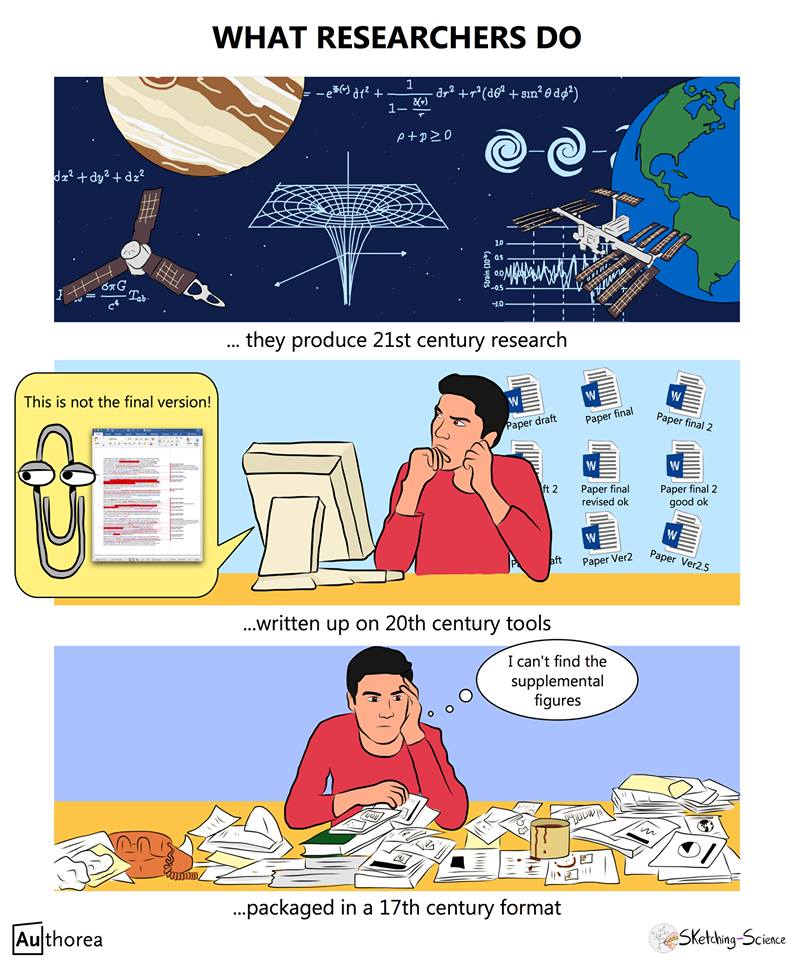The scientific paper format was a revolution in science. Before it, the scientific communication was made between few academics using letters and rare books. Then, during the XVII Century, a revolution arises to improve scientific communication. The first scientific magazines allowed the propagation of results, data and new techniques on a larger scale. The scientific paper leveraged scientific and technological progress. That was 350 years ago. Recently, an article from The Atlantic, Den vitenskapelige artikkelen er foreldet, forslag vi trenger en ny revolusjon innen forskningskommunikasjon.
This is a subject of great importance to be discussed by scientists. Are we succeeding in presenting our results in the current publishing format? Is the scientific paper format enough to present the new data in the 21st Century?
Since the first scientific papers were published, few changes have taken place. Yes, we publish online. However, We use “virtual paper sheets”, and called pdf. To illustrate the questioning, James Somers, the author of the atlantic article, cites an example given by Bret Victor, a researcher who worked at Apple: “After Gutenberg, the printing press was mostly used to mimic the calligraphy in bibles. It took nearly 100 years of technical and conceptual improvements to invent the modern book. There was this entire period where they had the new technology of printing, but they were just using it to emulate the old media.” Now, by far the most popular tool we have for communicating our results is the PDF—literally a simulation of a piece of paper.

The first scientific paper format was, usually, more direct, shorter, and less formal than the current papers. It seems that the more advanced science becomes, the more difficult it is to communicate using scientific papers. We use advanced softwares to generate our data and we need to present them in a paper sheet. Software is a dynamic medium; paper isn’t.
I fjor publiserte magasinet Nature en artikkel på nettet It’s not just you: science papers are getting harder to read for å diskutere økningen av jargong i dagens vitenskapelige artikkelformat.
Ifølge Somers, Dagens papirer er lengre enn noensinne og fulle av sjargong og symboler. They depend on chains of computer programs that generate data, and clean up data, and plot data, and run statistical models on data. These programs tend to be both so sloppily written and so central to the results that it’s contributed to a replication crisis, or put another way, a failure of the paper to perform its most basic task: to report what you’ve actually discovered, clearly enough that someone else can discover it for themselves.
Therefore, in an attempt to change this situation, many scientists are developing their own softwares. Or they move from the academia to private companies and start-ups. To explain that, Somers cite Galileo: “Galileo couldn’t go anywhere to buy a telescope, he had to build his own.”
We agree with that. Mind the Graph arose from the need for present our results in a more understandable way. We are scientists who believe in the revolutionary power of good communication in science.
Vil du lese mer om forskningskommunikasjon og det vitenskapelige artikkelformatet? Ta en titt på innleggene våre:
- Hvordan folk leser vitenskapelige artikler
- Er artikkelen din klar for fremtiden? Sosiale medier har også plass til vitenskapelig kommunikasjon.
Vi ønsker å redusere avstanden mellom forskere og allmennheten og forbedre måten vi kommuniserer vitenskap på. Vil du bli med oss?

Abonner på nyhetsbrevet vårt
Eksklusivt innhold av høy kvalitet om effektiv visuell
kommunikasjon innen vitenskap.






